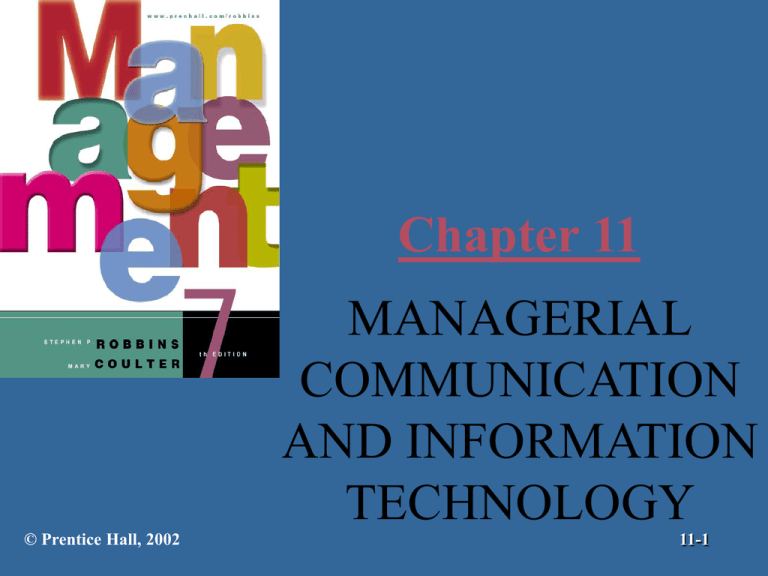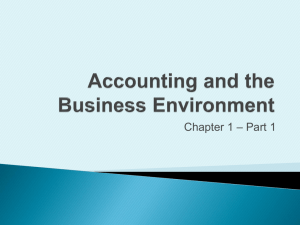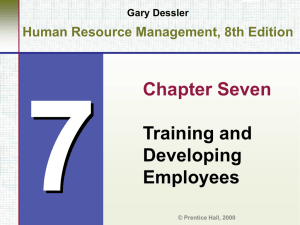Interpersonal communication
advertisement

Chapter 11 MANAGERIAL COMMUNICATION AND INFORMATION TECHNOLOGY © Prentice Hall, 2002 11-1 Learning Objectives You should learn to: – Explain the barriers to effective interpersonal communication and how to overcome them – Contrast the different organizational communication flows and networks – Describe two developments in information technology that have had a significant impact on managerial communication – Discuss how information technology affects organizations © Prentice Hall, 2002 11-2 Learning Objectives (cont.) You should learn to: – Define communication – Explain the interpersonal communication process – Describe the factors on which the different communication methods can be evaluated, and on what the choice of communication method depends – Tell how nonverbal communication affects managers © Prentice Hall, 2002 11-3 Understanding Managerial Communication What is Communication? • The transfer and understanding of meaning • If no information has been conveyed, communication has not occurred • Everything that a manager does involves communicating • Effective communication does not equal agreement. You may understand the meaning of the massage but do not agree with views. • Ineffective communication is the basis for many managerial problems • Interpersonal communication - occurs between people • Organizational communication - all the patterns, networks, and systems of communication in an organization © Prentice Hall, 2002 11-4 Process Of Interpersonal Communication Elements of the Process message - expresses the purpose of the communication. It can be the written document, the oral speech, and even the gestures and facial expressions we use. encoding - converting the message in symbolic form affected by the skills, attitudes, and knowledge of the sender, and by the culture of the organization. • A sender initiates a message by encoding a thought. • Four conditions influence the effectiveness of that encoded messages: skills, attitudes, knowledge of the sender, and the sociocultural system. • Example teaching at IUG. © Prentice Hall, 2002 11-5 Process Of Interpersonal Communication Elements of the Process channel - medium for conveying the message decoding - retranslating symbols into a message, affected by personal characteristics of the receiver noise - disturbances that interfere with the transmission, receipt, or feedback of a message • Message itself and channel can distort communications feedback also subject to same sources of noise © Prentice Hall, 2002 11-6 Process Of Interpersonal Communication Elements of the Process channel - medium for conveying the message a. Managers need to recognize that certain channels are more appropriate for certain messages. b. A manager might want to use multiple channels—this decreases the potential for distortion. Example: Choose the right channel for the follows: University would announce for new registration system, new furniture company established, a manager fired his employee because of lack of commitment. © Prentice Hall, 2002 11-7 Process Of Interpersonal Communication Elements of the Process The receiver is the individual to whom the message is directed. a. The receive must decode the message. b. Decoding accuracy is limited by the skills, attitudes, knowledge of the receiver, and sociocultural system. © Prentice Hall, 2002 11-8 Process Of Interpersonal Communication Elements of the Process • The feedback loop is the final link in the communication process. a. Feedback provides a check on whether understanding has been achieved. b. Because feedback can be transmitted along the same types of channels as the original message, it faces the same potential for distortion. © Prentice Hall, 2002 11-9 The Interpersonal Communication Process Message Medium Encoding Receiver Decoding Noise Sender Message Feedback © Prentice Hall, 2002 11-10 Process Of Interpersonal Communication (cont.) Methods of Communicating Interpersonally • a wide variety of communication methods exist • choice of a method should reflect: 1. the needs of the sender 2. the needs of the receiver 3. the attributes of the message 4. the attributes of the channel © Prentice Hall, 2002 11-11 Evaluating Communication Methods 1. Feedback - how quickly can the receiver respond to the message? 2. Complexity capacity - can the method effectively process complex messages? 3. Breadth potential - how many different messages can be transmitted using this method? 4. Confidentiality - can communicators be reasonably sure their messages are received only by those intended? 5. Encoding ease - can sender easily and quickly use this channel? 6. Decoding ease - can receiver easily and quickly decode messages? 7. Time-space constraint - do senders and receivers need to communicate at the same time and in the same space? © Prentice Hall, 2002 11-12 Evaluating Communication Methods 1. Cost - how much does it cost to use this method? 2. Interpersonal warmth - how well does this method convey interpersonal warmth? 3. Formality - does this method have the needed amount of formality? 4. Scanability - does this method allow the message to be easily browsed or scanned for relevant information? 5. Time of consumption - does sender or receiver exercise the most control over when the message is dealt with? © Prentice Hall, 2002 11-13 Comparison of Communication Methods © Prentice Hall, 2002 11-14 Process Of Interpersonal Communication (cont.) Methods of Communicating Interpersonally (cont.) • nonverbal communication - communication without words • Types • body language - gestures, facial expressions, and other body movements that convey meaning • verbal intonation - emphasis someone gives to words or phrases that conveys meaning • every oral communication is accompanied by a nonverbal message. • It is not what you said, it is how you said it. • nonverbal component usually carries the greatest impact © Prentice Hall, 2002 11-15 Facial Expressions Convey Emotions © Prentice Hall, 2002 11-16 Process Of Interpersonal Communication (cont.) Barriers to Effective Interpersonal Communication • Filtering - the deliberate manipulation/handling of information to make it appear more favorable to the receiver • upward communication is condensed by senders to avoid information overload by top-level receivers • extent of filtering affected by: • the number of vertical levels in the organization • culture of the organization: the importance of appearance. • Selective Perception - is when people selectively interpret what they see or hear on the basis of their interests, background, experience, and attitudes. © Prentice Hall, 2002 11-17 Process Of Interpersonal Communication (cont.) Barriers to Effective Interpersonal Communication (cont.) • Emotions - interpretation of a message affected by the way the receiver feels • extreme emotions likely to hinder effective communication • It’s best to avoid reacting to a message when the receiver is upset because he/she is not likely to be thinking clearly. • Information Overload - information available exceeds processing capacity. Such as 600 waiting e-mail messages in the in box. • frequent complaint of executives. a. Receivers tend to select out, ignore, pass over, or forget information when they have too much information. b. Or, receivers may put off further processing until the overload situation is over—still ineffective communication. © Prentice Hall, 2002 11-18 Process Of Interpersonal Communication (cont.) Barriers to Effective Communication (cont.) • Defensiveness - behaviors that result from feeling threatened. • engaging in behaviors such as verbally attacking others, making sarcastic remarks, being overly judgmental, and questioning others’ motives— happens when people feel that they’re being threatened. • hinders effective communication © Prentice Hall, 2002 11-19 Process Of Interpersonal Communication (cont.) Barriers to Effective Communication (cont.) • Language - meaning of words differs among people with diverse backgrounds. a. Age, education, and cultural background can influence language use and definition given to words b.Jargon is specialized terminology or technical language that members of a group use to communicate among themselves. • National Culture - cultural values affect the way people communicate • individualism versus collectivism © Prentice Hall, 2002 11-20 Process Of Interpersonal Communication (cont.) Overcoming the Barriers to Effective Interpersonal Communication • Use Feedback - ask a set of questions about a message to determine whether it was understood as intended • ask receivers to restate the message in their own words • Simplify Language - tailor the language to the audience for whom the message is intended. • jargon can facilitate understanding when used in appropriate groups. • Listen Actively - listen for full meaning a. Listening is an active search for meaning, whereas hearing is passive. b. Active listening is listening for full meaning without making premature judgments or interpretations, and demands total concentration. c. Active listening is enhanced by developing empathy with the sender— placing yourself in the sender’s position. d. Exhibit 11.4 on p. 292 lists other specific behaviors that active listeners demonstrate. © Prentice Hall, 2002 11-21 Active Listening Behaviors Avoid interrupting the speaker Be empathetic Make eye contact Paraphrase Don’t overtalk Avoid distracting actions or gestures © Prentice Hall, 2002 Active Listening Ask questions Exhibit affirmative head nods and appropriate facial expressions 11-22 Process Of Interpersonal Communication (cont.) Overcoming Communication Barriers (cont.) • Constrain Emotions - emotions severely cloud and distort the transference of meaning • refrain from communicating until one regains her/his composure • Watch Nonverbal Cues - actions should be aligned with words • nonverbal message should reinforce verbal message © Prentice Hall, 2002 11-23 Organizational Communication Formal Communication • communication that follows the official chain of command or is communication required to do one’s job • It takes place within prescribed organizational work arrangements. Informal Communication • not defined by the organization’s structural hierarchy. • It fulfills two purposes • permits employees to satisfy their needs for social interaction • creates alternative, and frequently faster and more efficient, channels of communication © Prentice Hall, 2002 11-24 Organizational Communication (cont.) Direction of Communication Flow • • • • • • Downward - flows from a manager to subordinates used to inform, direct, coordinate, and evaluate employees Upward - flows from subordinates to managers keeps managers aware of employees’ feelings source for ideas on improving operations The amount of upward communication is affected by the culture of the organization – trust and empowerment increase upward flow – mechanistic and authoritarian environment decrease upward flow © Prentice Hall, 2002 11-25 Organizational Communication (cont.) Direction of Communication Flow (cont.) • Lateral communication: takes place among employees on the same organizational level. Horizontal cross functional team. • Diagonal - cuts across both work areas and organizational levels • benefits efficiency and speed. • e-mail facilitates diagonal communication. • Diagonal communication has the potential to create problems if employees don’t keep their managers informed. © Prentice Hall, 2002 11-26 Organizational Communication Networks Organizational Communication Networks • combination of vertical and horizontal flows into a variety of patterns. • Types of Networks • chain - communication flows according to the formal chain of command, both direction. • wheel - flows between a clearly identifiable and strong leader and others in a work group or team. Leader serves as a hub through whom all communication passes. • all-channel - flows freely among all members of a work team • no single network is best for all situations © Prentice Hall, 2002 11-27 Three Common Organizations Communication Networks and How They Rate on Effectiveness Criteria © Prentice Hall, 2002 11-28 Organizational Communication (cont.) Organizational Communication Networks (cont.) Grapevine\gossip - an informal network that is active in almost every organization. • Important source of information. • Identifies issues that employees consider important and anxiety producing. • Can use the grapevine to disseminate important information. • Rumors can never be eliminated entirely a. The grapevine is active in almost every organization. One survey reported that 75 percent of employees hear about matters first through rumors on the grapevine. b. The grapevine can act as both a filter and a feedback mechanism. © Prentice Hall, 2002 11-29 Understanding Information Technology How Technology Affects Managerial Communication • Information technology has changed organizational communication. • Disseminates more complete information. • Provides more opportunities for collaboration. • Employees are fully accessible. • Two developments in information technology seem to be having the most significant impact: networked computer systems and wireless capabilities. • First: Networked Computer Systems - linking computers through compatible hardware and software. • Some of its communication applications are the follows: • e-mail - instantaneous transmission of written messages. • It is fast and cheap and can be used to send the same message to numerous people at the same time. © Prentice Hall, 2002 11-30 Understanding Information Technology (cont.) Effect of Technology (cont.) Networked Computer Systems - (cont.) • instant messaging (IM) - interactive real-time communication • requires groups to be logged on the computer network at the same time. E.g., communication among friends on line. • leaves network open to security breaches. • IM software is currently incompatible\contrary with important business applications software. • voice-mail - digitizes a spoken message • transmits message over the network. • stores the message for later retrieval. © Prentice Hall, 2002 11-31 Understanding Information Technology (cont.) Effect of Technology (cont.) Networked Computer Systems (cont.) • Fax - allows transmission of documents containing both text and graphics over ordinary telephone lines • Electronic data interchange (EDI) - permits the exchange of standard business transaction documents. such as invoices or purchase orders, using direct computer-tocomputer networks. Used with vendors, suppliers and consumers. • Teleconferencing - permits simultaneous conferral\talking using telephone or e-mail group communications software. • videoconferencing - participants can see each other . © Prentice Hall, 2002 11-32 Understanding Information Technology (cont.) Effect of Technology (cont.) Networked Computer Systems (cont.) • Intranet - Internet technology that links organizational employees. • Extranet - systems are organizational communication networks that use Internet technology and allow authorized users inside the organization to communicate with certain outsiders such as customers and vendors. • Internet-based voice communication - allows users to talk with each other. On Compaq web site, visitors can click on an icon and speak live to a company representative. • Second: Wireless Capabilities - depends on signals sent through space without any physical connection • based on microwave signals, satellites, radio waves, or infrared light rays © Prentice Hall, 2002 11-33 Understanding Information Technology (cont.) How Information Technology Affects Organizations? • communications among organizational members are no longer constrained by geography or time. • More cooperation and integration. • Effective decision making. • psychological drawback - personal costs associated with being constantly accessible. pressure to “check in” even during off hours. © Prentice Hall, 2002 11-34 Review • What types of communication does managerial communication encompass? Managerial communication encompasses both interpersonal communication—communication between two or more people—and organizational communication—all the patterns, networks, and systems of communication within an organization. • Why isn’t effective communication synonymous with agreement? A message can be clearly understood, but not agreed with. As long as the message is clearly understood, effective communication has happened. © Prentice Hall, 2002 11-35 Review • Which do you think is more important for the manager: speaking accurately or listening actively? Why? The answer will be varied. • How might managers use the grapevine for their benefit? Managers can stay on top of issues that concern employees and, in turn, can use the grapevine to disseminate important information. © Prentice Hall, 2002 11-36






